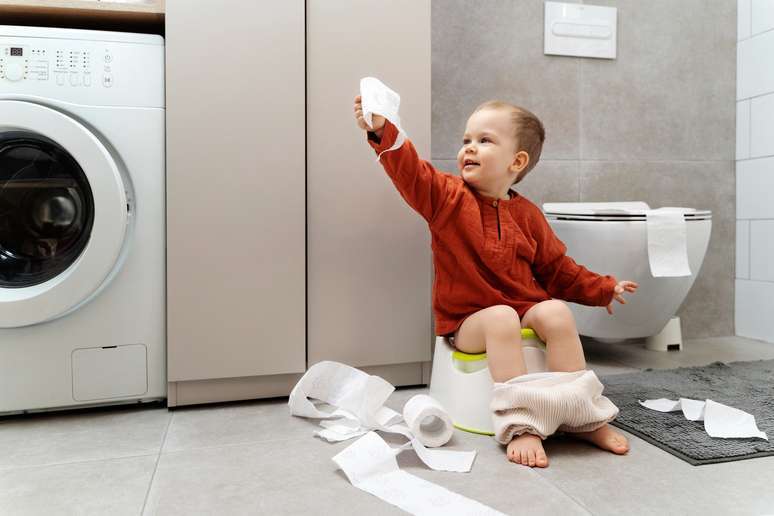This period requires patience and observation of the baby’s signals; learning how to create a consistent routine and adapt the environment to facilitate the transition.
One of the most feared phases for first-time parents, potty training is an important – and necessary – moment for the development of children. At this point, several doubts may arise: what if the adaptation takes time? Or if it is too complicated? Or if it is a lot of confusion? Here we will report some of these answers.
The main advice is to take your time and not rush the process too much. After all, potty training should be celebrated as a milestone in your child’s independence to ease (a lot) of the family routine and budget.
What is the ideal time?
The perfect time is never the same for everyone, but usually varies between 2 and 3 years. To identify it, observe the child’s signals: if he keeps the diaper dry longer, shows interest in using the bathroom, tells you when the diaper is dirty, goes in and takes off his clothes by himself and follows simple instructions, Maybe the time has come.
To start using the potty, avoid periods of major changes in the child’s life, such as moving house, the arrival of a sibling, or starting a new school. Also prepare the environment by purchasing a potty or toilet seat and provide easy-to-remove clothing, such as pants with elastic.
First steps
Introduce the potty (or potty with adapter) to the child and explain how it works. Leave it accessible and encourage the child to sit on it, even if dressed, so that he or she becomes familiar with it;
Create a routine by taking your child to the bathroom at specific times, such as when he or she wakes up, before and after meals, and before bed;
Watch for signs that your child needs to use the bathroom and take him there immediately.
Routine is essential
Since this is a new time for little ones, it is essential to maintain a regular routine. Although the introduction is gradual, little by little there should not be too much space between attempts.
Always take your child to the bathroom at regular times. Consistency and patience are essential to help her get used to the new practice and thus reduce the use of expensive diapers.
When to stop using diapers completely?
The final cessation of diaper use should be done when the child achieves full bladder control. This is when he is already able to understand his body’s signals to go to the bathroom both during the day and at night, holding urine until he reaches the bathroom. If your child wakes up every day with a dry diaper, it is a good sign that he is ready for this new step.
Toilet independence is also an important indicator. The child should be able to use the potty or toilet independently, including taking off clothes and cleaning themselves with minimal assistance.
Potty training during the day or at night?
Daytime potty training refers to the process of removing diapers during the day. It involves creating a routine, providing positive stimulation, and paying attention to your child’s body cues.
Nighttime potty training is an additional process that involves removing diapers at night. It usually takes longer, as it requires the child to develop the ability to control their bladder (and recognize when they need to go to the bathroom) while they sleep.
Stumbles along the road
During the potty training process, some common mistakes can occur that negatively affect your child’s progress.
One of the main ones is too much pressure to start potty training before the child is ready, which can create learning problems. Also, inconsistencies in the approach, such as frequent changes in routine or unrealistic expectations, can confuse little ones and prolong the process.
Another common mistake is to react negatively to accidents (e.g. bedwetting), such as criticizing or punishing the child. This can cause anxiety and insecurity, slowing down progress.
Not allowing your child to actively participate in the process, such as choosing the potty or letting him know when he needs to go to the bathroom, can also reduce motivation and prolong the time it takes for potty training.
Also, it is important to remember that the process of completely eliminating diapers can vary from child to child. Some may be ready from the beginning, while others may need more time.
It is essential to follow each other’s rhythm and be ready to face any obstacles.
Pediatricians
The help of pediatricians is essential throughout childhood, and it would be no different during potty training.
Pediatricians can help determine if a child is physically ready to begin the process by evaluating his or her physical development and bladder control.
Additionally, medical monitoring can help identify any underlying health issues that affect potty training, such as constipation or urinary tract infections.
Source: Terra
Rose James is a Gossipify movie and series reviewer known for her in-depth analysis and unique perspective on the latest releases. With a background in film studies, she provides engaging and informative reviews, and keeps readers up to date with industry trends and emerging talents.





-1hrj79c5c7oma.jpg)

